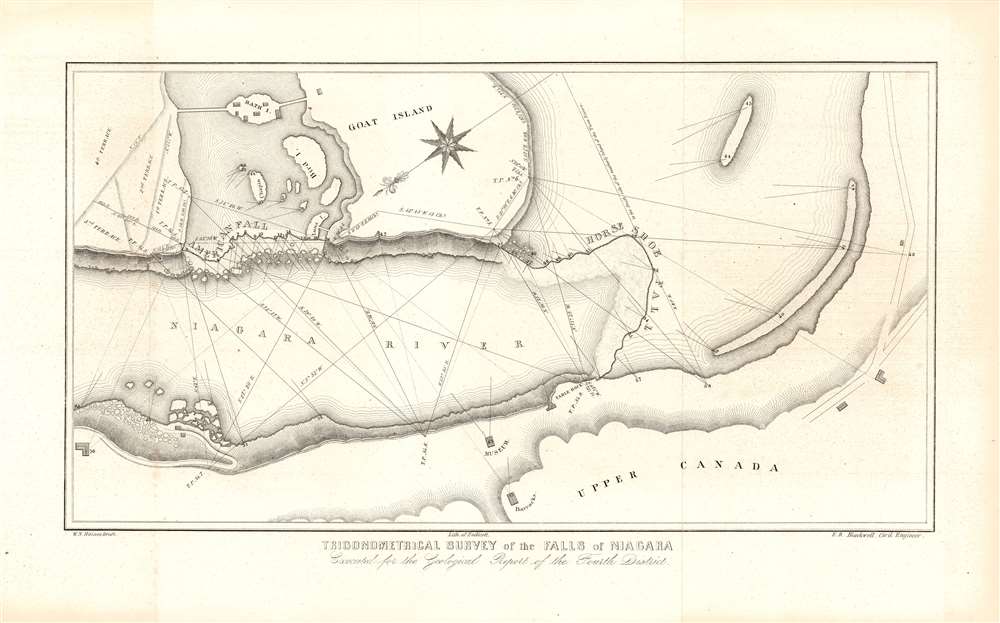1843 Blackwell Map of Niagara Falls, New York
NiagaraFalls-haines-1843-2
Title
1843 (undated) 9.5 x 16 in (24.13 x 40.64 cm) 1 : 5200
Description
A Closer Look
This map - oriented to the southeast - details both the American Falls, and the Horseshoe Falls in Canada. Also depicted are several islands and the river and buildings around the falls, including the Canadian barracks overlooking the falls, and the original location of the Niagara Falls Museum, the oldest museum in Canada. This, at the time, consisted solely of its founder's five-thousand-plus item taxidermy collection. In the decade to follow, the collection was increased by the additions of mastodon remains, a whale skeleton, and four Egyptian mummies. (The propriety of the inclusion of human remains in a taxidermy exhibit would not have been questioned in that era.) In 2002, one mummy from the collection was positively identified as belonging to Pharaoh Rameses I, who has since been repatriated to Egypt.Publication History and Census
This map was printed for inclusion in James Hall's Geology of New York; Part IV, having been drawn by W. S. Haines from an 1841 survey of the region. Hall's Geology is well represented in institutional collections.CartographerS
Edwin R. Blackwell (fl. c. 1835 - c. 1880) was an accomplished civil engineer living in Black Rock New York, near the Niagara Falls in the mid to late 19th century. Blackwell worked with various railroad companies and contractors as a surveyor and engineer and was highly regarding for this work in the Buffalo, New York area. Blackwell is best known for his 1841 work, in conjunction with Z. Allen, in the surveying of the Falls and calculation of the power of the Falls. Based on detailed measurements and various soundings Blackwell determined that the horse-power generated by the falls was 4,533,334. More by this mapmaker...
Endicott and Company (fl. c. 1828 - 1891) was a New York based family run lithography firm that flourished throughout the 19th century. The firm was founded by George and William Endicott, brothers who were born in Canton, Massachusetts. George Endicott (June 14, 1802 - 1848) trained as a lithographer under Pendleton Lithography from January 1826. He later worked as superintendent of Senefelder Company until the summer of 1828. Afterwards, in 1830, he relocated to Baltimore and partnered with Moses Swett. Endicott and Swett relocated to New York City in December 1831. They remained partners until July 1834 when the relationship dissolved. George set up shop on his own account at 359 Broadway. William Endicott (1815 - 1851), George's younger brother of 14 years, joined the firm in 1840 and was made a partner in 1845, after which the name of the firm was changed to G. and W. Endicott. George Endicott died shortly afterward, in 1848, but William continued operating the firm as William Endicott and Co. until his own 1851 death at just 35 years old. The firm was carried on by his widow Sara Munroe Endicott until it was taken over by her son, Francis Endicott, who ran the firm from 1852 to 1886. George Endicott, Jr. subsequently ran the firm from 1887 to 1891. Peters, in his important work on American lithography America on Stone writes 'it is hard to summarize the Endicotts. They did everything and did it well . . . [they] worked with and for Currier and Ives, yet in spite of all that much of their work lacks real individuality.' The Endicott firm was responsible for many 19th century views and plans of New York City and state as well as plans of Sacramento, California, and the Midwest. Learn More...

